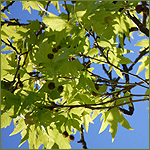The long-standing debate about why autumn leaves change colour has new impetus from the humble apple tree, the BBC News website reports.
 Domesticated apples – selectively bred for fruit size and taste rather than insect defence – tend to have less red leaves than their wild cousins.
Domesticated apples – selectively bred for fruit size and taste rather than insect defence – tend to have less red leaves than their wild cousins.
Researchers suggest that fact supports one theory for the change: that autumn’s red colours ward off insects, indicating a plant’s chemical defences.
The research is published in Proceedings of the Royal Society B. However, other experts remain sceptical of this “co-evolution” theory.
The idea, taking into account the full range of autumn colours, was first suggested in 2001 by the late biologist Bill Hamilton.
More recent research, however, has shown that autumn’s oranges and yellows are caused by carotenoids.
These are pigment molecules present year-round, normally serving to protect chlorophyll – the green-coloured molecule at the heart of photosynthesis – from damage caused by sunlight.
In the autumn, as chlorophyll is actively broken down in the leaves, the carotenoids become visible.
Autumn’s brilliant reds and purples, however, are caused by molecules called anthocyanins that are produced during the same period.
It is a costly job of molecule building for the plant and an enigma to scientists, since the leaves will at that point soon be dropped entirely.
“If you wanted to prove this hypothesis that the autumn colours are necessary to repel insects, what you would do is take two populations of trees and let them evolve – one with and one without the insects – expecting the one without insects would lose its colours,” said author of the research Marco Archetti, of the University of Oxford’s zoology department.
“That’s exactly what’s been done starting 2,000 years ago when they started to domesticate apple trees, because they’ve been sheltered from the influence of insects and parasites,” Dr Archetti explained.
“There is no longer natural selection; what is going on is artificial selection by the farmer for fruit size and flavour, not resistance against insects.”
David Wilkinson, an environmental scientist at Liverpool John Moores University who has published on the leaf colour debate, says that the work is not proof positive of the co-evolution theory.
“There’s a difference between a ‘signal’ and a ‘cue’,” he explained.
“A cue is something that hasn’t evolved for a signalling function but is used by something else as information that affects its behaviour.
“But that doesn’t mean that the autumn colour has evolved for that purpose.”
Dr Wilkinson points out that a competing theory holds that anthocyanins are performing a different task altogether.
Plants are known to break down components of their leaves and harvest a number of precious compounds – particularly those containing nitrogen – before cutting the leaves loose entirely.
“I think the most likely explanation is that these [anthocyanins] are effectively sunscreens that allow the photosynthesis to continue as the machinery of photosynthesis is broken apart in the autumn.
“The idea of, as it were, ‘the trees are talking to the insects’, is wild and wacky and it would be rather nice if it were true.
“But I still have not seen anything that convinces me of the signalling.”
Dr Archetti believes that the loss of red leaves among domesticated plants cannot be explained by the “photoprotection” theory favoured by Dr Wilkinson.
He now intends to study apricot and walnut trees, the domesticated varieties of which he says have also experienced the loss of autumn’s reds.
Source: BBC News website
Date: 15/04/2009
Filed under: autumn, autumn colour, research | Tagged: apple trees, autumn, autumn colours, environment, evolution, royal society | Leave a comment »





